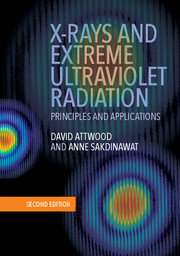Book contents
- Frontmatter
- Dedication
- Contents
- Preface to the Second Edition
- Acknowledgments for the Second Edition
- Preface to the First Edition
- Acknowledgments for the First Edition
- 1 Introduction
- 2 Radiation and Scattering at EUV and X-Ray Wavelengths
- 3 Wave Propagation and Refractive Index at X-Ray and EUV Wavelengths
- 4 Coherence at Short Wavelengths
- 5 Synchrotron Radiation
- 6 X-Ray and EUV Free Electron Lasers
- 7 Laser High Harmonic Generation
- 8 Physics of Hot Dense Plasmas
- 9 Extreme Ultraviolet and Soft X-Ray Lasers
- 10 X-Ray and Extreme Ultraviolet Optics
- 11 X-Ray and EUV Imaging
- Appendix A Units and Physical Constants
- Appendix B Electron Binding Energies, Principal K- and L-Shell Emission Lines, and Auger Electron Energies
- Appendix C Atomic Scattering Factors, Atomic Absorption Coefficients, and Subshell Photoionization Cross-Sections
- Appendix D Mathematical and Vector Relationships
- Appendix E Some Integrations in k, ω-Space
- Appendix F Lorentz Space-Time Transformations
- Appendix G Some FEL Algebra
- Appendix H Ionization Rates of Noble Gas Atoms as a Function of Laser Intensity and Pulse Duration at 800 nm Wavelength
- Index
Preface to the Second Edition
Published online by Cambridge University Press: 24 November 2016
- Frontmatter
- Dedication
- Contents
- Preface to the Second Edition
- Acknowledgments for the Second Edition
- Preface to the First Edition
- Acknowledgments for the First Edition
- 1 Introduction
- 2 Radiation and Scattering at EUV and X-Ray Wavelengths
- 3 Wave Propagation and Refractive Index at X-Ray and EUV Wavelengths
- 4 Coherence at Short Wavelengths
- 5 Synchrotron Radiation
- 6 X-Ray and EUV Free Electron Lasers
- 7 Laser High Harmonic Generation
- 8 Physics of Hot Dense Plasmas
- 9 Extreme Ultraviolet and Soft X-Ray Lasers
- 10 X-Ray and Extreme Ultraviolet Optics
- 11 X-Ray and EUV Imaging
- Appendix A Units and Physical Constants
- Appendix B Electron Binding Energies, Principal K- and L-Shell Emission Lines, and Auger Electron Energies
- Appendix C Atomic Scattering Factors, Atomic Absorption Coefficients, and Subshell Photoionization Cross-Sections
- Appendix D Mathematical and Vector Relationships
- Appendix E Some Integrations in k, ω-Space
- Appendix F Lorentz Space-Time Transformations
- Appendix G Some FEL Algebra
- Appendix H Ionization Rates of Noble Gas Atoms as a Function of Laser Intensity and Pulse Duration at 800 nm Wavelength
- Index
Summary
There has been a remarkable improvement in capabilities for probing matter with x-rays and extreme ultraviolet (EUV) radiation since the previous edition of this book appeared in 2000. The spectral brightness and coherence of available research facilities has increased by many orders of magnitude across the EUV and x-ray spectral regions, extending from photon energies of 30 eV (40 nm wavelength) to 50 keV (0.25 Å). The ability to probe electron dynamics in atoms, molecules, clusters and solids has been extended from picoseconds to femtoseconds and attoseconds. X-ray optics have improved dramatically, with reflective and diffractive optics now able to focus, or resolve images, to 10 nm across much of this spectrum. New techniques have emerged for attosecond temporal measurements, nanoscale tomographic imaging of individual cells, and ever more sophisticated coherent diffraction and imaging techniques. Commercial capabilities have also improved with brighter laboratory sources and widely available x-ray microscopes for nanoscale imaging in the research and commercial sectors. And it appears that high-volume manufacturing of computer chips with 13.5 nm EUV radiation will soon become a reality, likely reaching world markets at the 7 nm node in 2017.
- Type
- Chapter
- Information
- X-Rays and Extreme Ultraviolet RadiationPrinciples and Applications, pp. xiiiPublisher: Cambridge University PressPrint publication year: 2017

